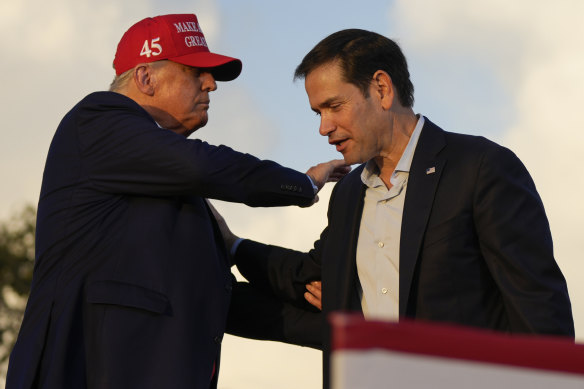
Given Trump’s proposed universal baseline tariffs of 10 to 20 per cent on all imports, but more particularly a 60 per cent tariff on imports from China, it is not surprising that he would stack the new administration with China hawks.
If the self-proclaimed “Tariff Man” follows through with his campaign promises, it would inevitably have a significantly deleterious impact on China’s economy, even though it has reduced its dependence on exports to the US since the last trade war. Exports to the US, while about $US500 billion a year, now represent less than 15 per cent of its total exports.
Loading
There are some estimates that a 60 per cent tariff would halve China’s economic growth rate. It would certainly reduce it, depending on the scale of China’s response.
It could depreciate the yuan, blunting the effect to some degree and making its exports even more competitive in the process. It would almost certainly bring on the major stimulus to domestic consumption that economists inside and outside China have been calling for.
The 10 trillion yuan ($2.1 trillion) debt relief package Beijing recently announced for local governments over the next few years is primarily aimed at stabilising their finances and dealing with the estimated 14.3 trillion yuan of hidden or off-balance-sheet local government debt. It would also give them more capacity to perform their usual role as conduits for Beijing’s stimulus programs. Their indebtedness has limited that capacity.
Until the Trump administration takes power next year, it isn’t possible to know whether the threat of the 60 per cent tariff for China is real or a bluff.

Donald Trump with Marco Rubio on the campaign trail. Rubio has called China “the most powerful adversary the United States has faced in living memory”.Credit: AP
In his previous term, Trump used the trade war as leverage to coerce China into a deal under which it pledged to buy an additional $US200 billion a year of US products. China bought only a little more than half that target and ended up importing less from the US than before the trade war began in 2018.
There are some in Trump’s orbit, Lighthizer among them, who again advocate using tariffs as leverage to get better deals from America’s trade partners, despite the less-than-successful outcomes last time.
Trump, who is very transactional and fancies himself as a dealmaker, might believe he can out-negotiate and intimidate America’s trade partners and gain better terms for US exports and more inbound investment. He also believes, erroneously, that tariffs on imports to the US are paid for by the exporters rather than US businesses and consumers.
Loading
That misunderstanding of how tariffs work means he believes he can use revenue from them to fund big tax cuts for US companies and the wealthy, so he might not want to trade away that revenue – in reality, a form of consumption tax on US consumers – in negotiated deals.
For China, the uncertainty about the nature of Trump’s new trade wars means it can only prepare for the worst while hoping, given the relative success in negotiations that led to the 2020 trade truce, that Trump does try to use the tariffs as leverage.
In some respects, China is better prepared for a new trade war than it was in 2018; in others, it’s more vulnerable.
Since the 2020 deal, it has introduced export controls over the minerals vital to most advanced technologies and whose production and supply chains it dominates. It has introduced an “entity” list that identifies and effectively licences individual foreign investments within China, enabling retaliation.
Beijing also saw in the 2018 trade war that its retaliatory tariffs, particularly on US agricultural exports, were quite painful. That Trump administration had to fund $US28 billion in subsidies to farmers to offset the impact.
Today, Beijing is also less reliant on the US for food imports than it was then, having deliberately built a much bigger agricultural trade relationship with Brazil.
Its economy is, however, weaker and its reliance on exports greater than it was during the earlier Trump presidency – though its export markets are now more diversified.
Xi Jinping’s strategy of seeking domination of key advanced technologies and his aversion to consumption-boosting stimulus has led to massive growth in exports, growth that has surged this year as domestic demand weakened and companies also started “front-loading” their exports as insurance against a Trump return.
Loading
The fragility of the domestic economy and an over-reliance on exports causing friction – not just with the US but its other major export markets – create vulnerabilities should a new global trade war erupt.
It would be even more affected if the US – recognising that Chinese companies have re-routed their exports via the likes of Vietnam, Malaysia, Thailand, Mexico and Canada since 2020 – ramped up the tariffs on those exports, too.
The key personnel choices an incoming president makes provide clear signals of intent and, so far, Trump is showing a preference for those with ideological positions on China rather than the slightly more pragmatic people in key economic positions within the Biden administration.
That is likely to lead to some level of confrontation on trade, in particular. The as-yet unanswered question is whether it will be Trump the Great Dealmaker or Trump the Tariff Man who retakes the Oval Office in January. It’s a question of great consequence for China, and the rest of the world.
The Market Recap newsletter is a wrap of the day’s trading. Get it each weekday afternoon.









 Add Category
Add Category